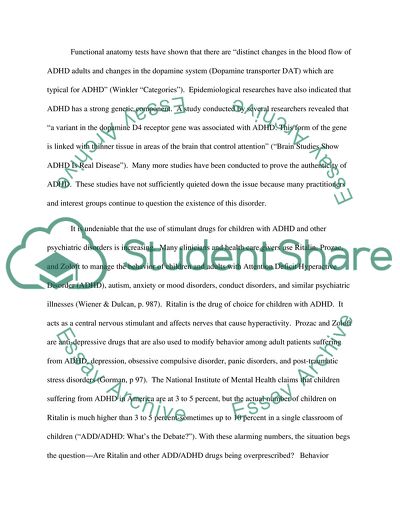
- Home
- Free Samples
- Premium Essays
- Editing Services
- Extra Tools
- Essay Writing Help
- About Us
- Studentshare
- Subjects
- Miscellaneous
- Stimulant Drug Use for Behavior Modification
Stimulant Drug Use for Behavior Modification - Essay Example

- Subject: Miscellaneous
- Type: Essay
- Level: Masters
- Pages: 4 (1000 words)
- Downloads: 0
- Author: xoberbrunner
Extract of sample "Stimulant Drug Use for Behavior Modification"
3). Owing to the usual nature of children, many take issue with this clinical disorder, saying that practitioners and some parents jump too easily to an ADHD diagnosis. They also argue that humans by nature possess different characteristics--some may be introvertly shy and others are unsurprisingly hyperactive. This presents a difficulty in diagnosing the disease because as Wrong Diagnosis.com points out, “at what point in the range of behavior is a ‘hyperactive’ child suffering from clinical hyperactivity?
” (“Misdiagnosis of Attention Deficit Hyperactivity Disorder”). The symptoms of hyperactivity and inattentiveness may also indicate other diseases like bipolar disorder, restless legs syndrome, hearing problems, or in some instances--emotional problems. In some instances, highly intelligent children may also present with hyperactive symptoms and their hyperactivity is usually just a manifestation of their boredom. There are too many factors to consider before a definite diagnosis for ADHD can be made.
And even when it is made, the lingering questions remain about the authenticity of the condition as a psychiatric disorder. Functional anatomy tests have shown that there are “distinct changes in the blood flow of ADHD adults and changes in the dopamine system (Dopamine transporter DAT) which are typical for ADHD” (Winkler “Categories”). Epidemiological researches have also indicated that ADHD has a strong genetic component. A study conducted by several researchers revealed that “a variant in the dopamine D4 receptor gene was associated with ADHD.
This form of the gene is linked with thinner tissue in areas of the brain that control attention” (“Brain Studies Show ADHD Is Real Disease”). Many more studies have been conducted to prove the authenticity of ADHD. These studies have not sufficiently quieted down the issue
...Download file to see next pages Read MoreCHECK THESE SAMPLES OF Stimulant Drug Use for Behavior Modification
Drug Addiction and Drug Abusers
Medication of Children with Attention Deficit Disorder
Nature of Post-War Drug Use
Evidence Base Practice/ Literature Review
Behavior modification for children with ADHD
Criminal Justice Issues
What Evidence Underpins the Use of Medication for Supporting Students with ADHD
The Prohibition of Body Modifications to Improve Performance in Sports

- TERMS & CONDITIONS
- PRIVACY POLICY
- COOKIES POLICY